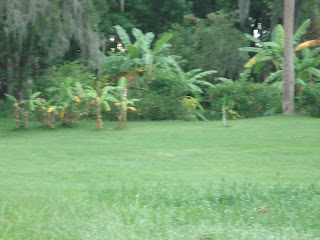It’s an eclectic mix of homes from the 20’s to the present. A neighborhood of the past, unlike the subdivisions of today. But what makes it such a wild place is the inhabitants. No, not the neighbors who live in the homes on our street, but the ones who live in the trees, the lake and the wooded areas. The place

has a wildness about it - a touch of “Old Florida.” Century old live oaks that could tell some tales if only they could talk, alligators and herons just feet apart in the tannin-colored water, unusually large Pileated woodpeckers snatching insects off old maple trees with rotted out cavities in their trunks, hawks taking off with field mice and snakes in their talons, osprey who raise their young in nests perched atop the bald cypress trees,
an otter that hobbles down the road in the early morning hours, fireflies alight in the tall grass of the neighboring field, and many nocturnal animals I have yet to see. The area is alive with the sound of nature - frogs croaking at night, osprey chatting all day, crickets making music as they rub their limbs together and grasshoppers humming.

There is a mix of tree varieties - none of them having been planted by anyone. The live oaks draped heavily in Spanish moss, maples, bald cypress, cabbage and queen palms, camphor, mulberry, sweet gum and even banana plants.

But the Cabbage palms (state palm) splattered throughout the wide expanses of open fields speak to me the deepest. Grown from a seed dropped by a bird of unknown species, left undisturbed for years to grow on their own. It’s this vision of the cabbage palms more than any other that gives this place a feel of the wild for me. It is a vision from my childhood. A once common sight along Florida highways that I remember well - A group of tall and lanky palms thriving in open fields of green with a background of clear blue sky and puffed up white clouds. It is an ordinary landscape scene in old paintings of Florida. One that is seen less often as more and more of Florida is gobbled up by development. It is these Cabbage palms that I cherish the most. They remind me of how Florida used to be.
I know there are many more “wild” neighbors I’ve yet to meet, and I look forward to discovering them in this place that speaks to the soul.










































.jpeg)




















